Mandarin Duck
- February 19, 2024
- 0 comment
The Mandarin duck, scientifically known as Aix galericulata, is a stunningly beautiful waterfowl native to East Asia. Renowned for its vibrant plumage and graceful demeanor, this species captivates admirers worldwide. The male Mandarin duck boasts an extravagant palette of colors, including bright orange “sails” on its back, a purple breast, and distinctive white markings on its face, while the female exhibits a more subdued yet elegant appearance with mottled brown and white feathers. These ducks primarily inhabit wooded areas near lakes, ponds, rivers, and marshes, favoring densely vegetated habitats with ample cover and nesting sites.

Mandarin ducks are primarily dabbling ducks, feeding on aquatic plants, seeds, insects, and small invertebrates, showcasing remarkable swimming and diving abilities. During the breeding season, males perform elaborate courtship displays to attract females, and once paired, they build nests in tree cavities or among dense vegetation near water bodies. Mandarin ducks hold significant cultural symbolism in East Asian traditions, representing love, fidelity, and marital bliss, and are often depicted in traditional art, symbolizing harmony and prosperity.
Despite facing threats such as habitat loss, pollution, and hunting, conservation efforts are underway to protect and preserve these iconic birds for future generations to cherish and admire.
| Specifications | Details |
|---|---|
| Scientific Name | Aix galericulata |
| Common Name | Mandarin duck |
| Native to | East Asia |
| Plumage (Male) | Vibrant colors, including bright orange “sails” on its back, purple breast, and white markings on its face |
| Plumage (Female) | Mottled brown and white feathers |
| Habitat | Wooded areas near lakes, ponds, rivers, and marshes |
| Diet | Aquatic plants, seeds, insects, and small invertebrates |
| Feeding Behavior | Dabbling ducks; swim and dive for food |
| Breeding Season | Spring |
| Nesting Sites | Tree cavities or dense vegetation near water bodies |
| Courtship Display | Elaborate rituals performed by males to attract females |
| Cultural Significance | Symbol of love, fidelity, and marital bliss in East Asian traditions |
| Conservation Status | Near Threatened |
| Threats | Habitat loss, pollution, hunting |
| Conservation Efforts | Habitat restoration, public awareness campaigns, establishment of protected areas |

Mandarin ducks, scientifically known as Aix galericulata, are strikingly beautiful waterfowl native to East Asia. They are known for their vibrant plumage and graceful demeanor, making them a popular subject in art, literature, and folklore.
Physical Characteristics
Appearance
Mandarin ducks are renowned for their stunning and vibrant appearance. The male Mandarin duck exhibits a flamboyant array of colors, including bright orange “sails” on its back, a deep purple breast, and distinctive white markings on its face. These striking colors are accentuated by intricate patterns and delicate feather details. In contrast, the female Mandarin duck has a more subdued appearance, with mottled brown and white feathers that provide camouflage in their natural habitat. Despite the female’s less vibrant plumage, she still possesses an understated elegance that complements the male’s bold colors.
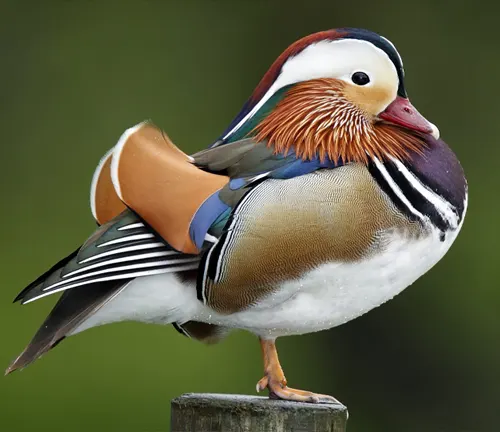
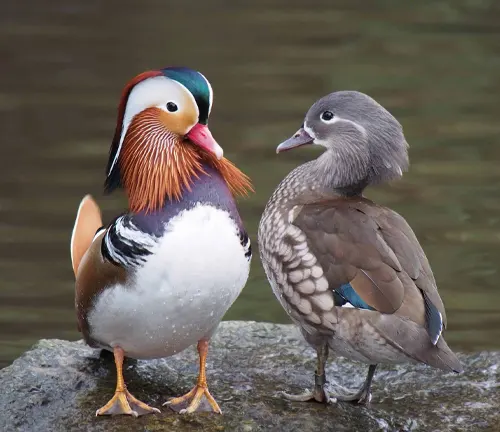
Sexual Dimorphism
One of the most fascinating aspects of Mandarin ducks is their pronounced sexual dimorphism, meaning there are distinct differences in appearance between males and females. This dimorphism is particularly evident in their plumage. As described earlier, males boast vibrant and colorful plumage, while females have a more understated and camouflaged appearance. Additionally, males are slightly larger in size and have a more pronounced crest on their heads compared to females. This striking difference in appearance between males and females is a common feature among many species of ducks and serves various purposes, including mate attraction and species recognition.
Habitat and Distribution
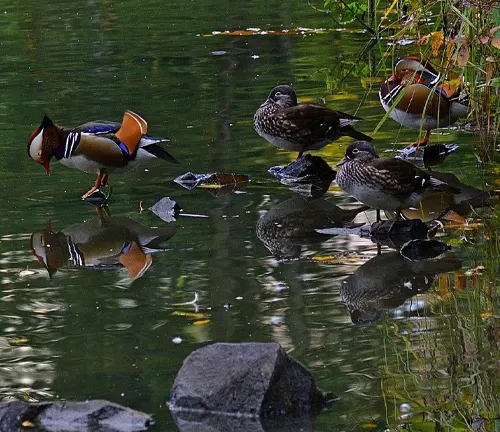
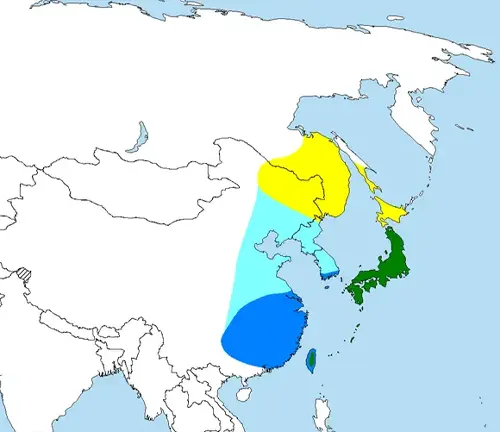
Mandarin ducks are primarily found in East Asia, including regions of China, Japan, Korea, and parts of Russia. They inhabit wooded areas near lakes, ponds, rivers, and marshes, preferring habitats with dense vegetation and ample cover. These waterfowl thrive in environments where they have access to freshwater sources for feeding and nesting.
In their natural habitat, Mandarin ducks seek out areas with abundant vegetation for shelter and nesting sites. They are often found in densely forested areas near water bodies, where they can forage for food and find suitable nesting locations. Their preference for wooded habitats provides them with protection from predators and allows them to engage in their courtship rituals and mating behaviors with minimal disturbance.
While Mandarin ducks are native to East Asia, they have been introduced to other parts of the world, including Europe and North America, primarily as ornamental birds in park settings and private collections. However, established populations outside of their native range are generally limited, and they are not considered widespread in these regions.
Behavior and Diet


Mandarin ducks are primarily dabbling ducks, meaning they feed by tipping forward in the water to reach submerged vegetation and small aquatic creatures. Their diet consists of a variety of food items, including aquatic plants, seeds, grains, insects, small fish, and invertebrates. They are opportunistic feeders and will adjust their diet based on seasonal availability and local habitat conditions.
In their natural habitat, Mandarin ducks are often observed foraging along the edges of lakes, ponds, rivers, and marshes, using their specialized bills to sift through mud and shallow water in search of food. They are agile swimmers and divers, capable of navigating through dense vegetation and shallow waters to access their prey.
Mating and Reproduction


Mandarin ducks exhibit fascinating mating behaviors and have a unique reproductive process. During the breeding season, which typically occurs in spring, male Mandarin ducks engage in elaborate courtship displays to attract females. These displays involve a series of intricate movements, vocalizations, and visual cues intended to impress potential mates.
Once a male successfully courts a female and forms a pair bond, the couple will search for a suitable nesting site. Mandarin ducks prefer nesting locations in tree cavities or among dense vegetation near water bodies, providing shelter and protection for their eggs and young.
After selecting a nesting site, the female will lay a clutch of eggs, typically numbering between 9 to 12 eggs, although clutch sizes can vary. Both the male and female Mandarin ducks take turns incubating the eggs, with the female usually incubating during the night and the male taking over during the day.
Cultural Significance

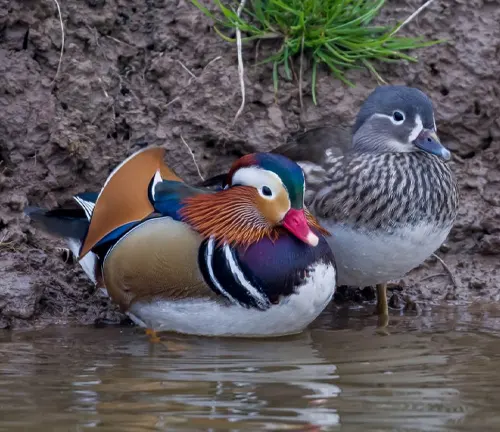
Mandarin ducks hold significant cultural symbolism in various East Asian traditions, representing love, fidelity, and marital bliss. Throughout history, these strikingly beautiful birds have been revered and celebrated in art, literature, folklore, and rituals.
In Chinese culture, Mandarin ducks are regarded as symbols of enduring love and conjugal fidelity. They are often depicted in traditional art, such as paintings and embroidery, as well as in decorative motifs on ceramics, textiles, and other cultural artifacts. Mandarin ducks are also featured prominently in Chinese mythology and folklore, where they are portrayed as devoted partners who mate for life.
Conservation Status
The conservation status of Mandarin ducks is of concern due to various threats to their natural habitats and populations. While the Mandarin duck is not currently listed as globally threatened, its status varies across different regions and populations.
The International Union for Conservation of Nature (IUCN) classifies the Mandarin duck as “Least Concern” on the global scale. However, localized populations may face greater threats and are classified differently based on regional assessments. For example, in certain parts of its range, such as Japan and Korea, the Mandarin duck is considered to be of “Least Concern” due to relatively stable populations and adequate conservation measures.
Threats and Challenges
Mandarin ducks face a range of threats and challenges to their survival in the wild. These threats primarily stem from human activities and environmental changes that impact their habitats and populations.


- Habitat Loss and Degradation: The destruction and degradation of wetland habitats, including lakes, ponds, rivers, and marshes, pose a significant threat to Mandarin ducks. Urbanization, agricultural expansion, and infrastructure development result in the loss of critical breeding, feeding, and nesting sites.
- Pollution: Pollution of water bodies, including contamination from industrial runoff, agricultural chemicals, and household waste, adversely affects water quality and poses health risks to Mandarin ducks and their prey species. Pollution can lead to habitat degradation, reduced food availability, and reproductive issues.
- Illegal Hunting and Poaching: Despite legal protections in many regions, Mandarin ducks are still targeted by illegal hunting and poaching for their meat, feathers, and eggs. Overexploitation of duck populations can lead to declines in numbers and disrupt breeding dynamics, further threatening their survival.
- Competition with Invasive Species: Invasive species, such as non-native plants and animals, can outcompete native species for resources and habitat space. In some areas, invasive species may directly prey on Mandarin duck eggs or young, reducing reproductive success and population viability.
- Climate Change: Climate change is altering habitats and ecosystems, affecting the availability of suitable breeding and feeding areas for Mandarin ducks. Shifts in temperature and precipitation patterns can disrupt migration routes, alter food availability, and increase the frequency and severity of extreme weather events.
- Human Disturbance: Human activities, such as recreational boating, fishing, and tourism, can disturb nesting sites, disrupt feeding behavior, and cause stress to Mandarin ducks. Disturbances during the breeding season can lead to nest abandonment and reduced reproductive success.
Efforts in Conservation
Efforts to conserve Mandarin ducks and their habitats are crucial for ensuring the long-term survival of this iconic species. Conservation initiatives focus on protecting critical habitats, reducing threats, and raising awareness about the importance of preserving biodiversity. Here are some key efforts in conservation:
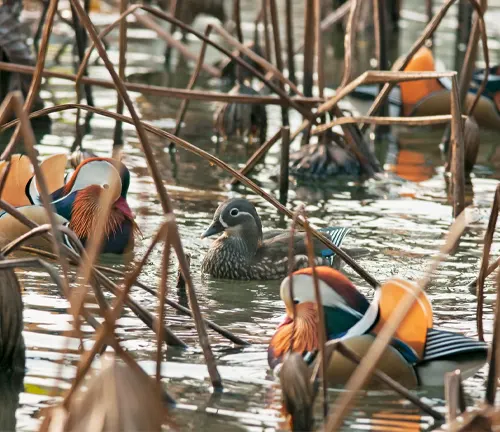

- Habitat Restoration: Conservation organizations and government agencies work to restore and protect wetland habitats, including lakes, ponds, rivers, and marshes, which are essential for Mandarin ducks and other wildlife. Habitat restoration efforts may include reforestation, wetland reclamation, and erosion control projects.
- Establishment of Protected Areas: Designating protected areas, such as national parks, wildlife reserves, and wetland sanctuaries, helps safeguard vital habitats for Mandarin ducks. These protected areas provide refuge from human disturbances, hunting, and habitat destruction, allowing duck populations to thrive.
- Law Enforcement: Enforcing laws and regulations against illegal hunting, poaching, and habitat destruction is essential for protecting Mandarin ducks and their habitats. Law enforcement agencies collaborate with local communities, conservation groups, and stakeholders to deter illegal activities and prosecute offenders.
- Public Awareness Campaigns: Educating the public about the importance of conserving Mandarin ducks and wetland ecosystems is critical for garnering support and fostering stewardship. Public awareness campaigns raise awareness about threats facing Mandarin ducks, promote sustainable practices, and encourage community involvement in conservation efforts.
- Research and Monitoring: Scientists and researchers conduct studies to better understand the ecology, behavior, and population dynamics of Mandarin ducks. Monitoring programs track duck populations, assess habitat conditions, and evaluate the effectiveness of conservation measures, informing adaptive management strategies.
- Community Engagement: Engaging local communities in conservation initiatives is essential for achieving long-term conservation goals. Community-based conservation projects involve stakeholders in habitat restoration, ecotourism development, and sustainable livelihood initiatives, fostering a sense of ownership and stewardship over natural resources.
- International Collaboration: Collaborative efforts between countries, conservation organizations, and international agencies are vital for conserving migratory species like Mandarin ducks. International agreements, such as the Ramsar Convention on Wetlands and the Convention on Migratory Species, facilitate cooperation and coordination in protecting critical habitats and migratory routes.
Different Species
Aix galericulata galericulata
This is the nominate subspecies found in East Asia, including China, Japan, Korea, and parts of Russia. It is the most widely recognized and studied subspecies of the Mandarin duck.
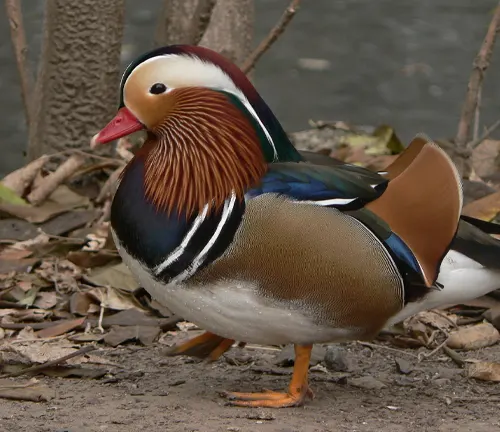

Aix galericulata sibirica
This subspecies is found in eastern Russia and Siberia. It may have subtle differences in plumage compared to the nominate subspecies.
Aix galericulata mandarina
This subspecies is native to Taiwan and is sometimes considered distinct from the nominate subspecies due to differences in plumage and genetics.
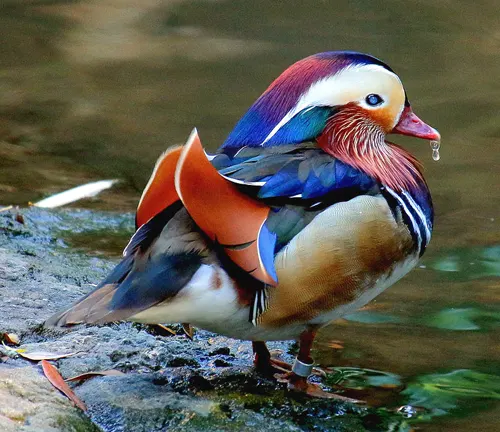
Frequently Asked Questions (FAQs)
- What is a Mandarin duck?
A Mandarin duck (Aix galericulata) is a species of waterfowl native to East Asia known for its vibrant plumage and graceful appearance. - Where do Mandarin ducks live?
Mandarin ducks primarily inhabit wooded areas near lakes, ponds, rivers, and marshes in East Asia, including China, Japan, Korea, and parts of Russia. - What do Mandarin ducks eat?
Mandarin ducks feed on a diet consisting of aquatic plants, seeds, insects, and small invertebrates. They are dabbling ducks, often seen swimming and diving for food. - Are Mandarin ducks endangered?
While Mandarin ducks are classified as “Near Threatened” by the IUCN, localized populations may face greater threats due to habitat loss, pollution, and hunting. - Do Mandarin ducks mate for life?
While Mandarin ducks are known to form strong pair bonds during the breeding season, they do not necessarily mate for life. However, they often exhibit long-term monogamous relationships. - Can Mandarin ducks be kept as pets?
While some individuals may attempt to keep Mandarin ducks as pets, it is generally not recommended due to their specialized needs and legal considerations. They require ample space, access to natural water bodies, and specific dietary requirements. - Do Mandarin ducks migrate?
Mandarin ducks are primarily sedentary birds, although some populations may undertake seasonal movements in search of suitable breeding or feeding grounds. - What is the significance of Mandarin ducks in Asian culture?
Mandarin ducks hold significant cultural symbolism in East Asian traditions, representing love, fidelity, and marital bliss. They are often depicted in traditional art and literature as symbols of harmony and prosperity. - How can I support Mandarin duck conservation efforts?
You can support Mandarin duck conservation efforts by raising awareness, participating in habitat restoration projects, and supporting organizations dedicated to wildlife conservation. - Are there different species of Mandarin ducks?
While there are various subspecies of Mandarin ducks with minor variations in plumage coloration and distribution, they all belong to the same species, Aix galericulata. - Can Mandarin ducks fly?
Yes, Mandarin ducks are capable of flight, although they are primarily terrestrial and rely on flight for migration and dispersal. - Do Mandarin ducks have any predators?
Common predators of Mandarin ducks include larger birds of prey, such as hawks and owls, as well as terrestrial predators like foxes and raccoons.


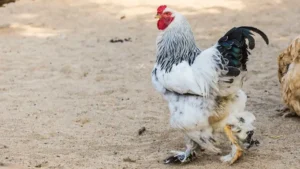
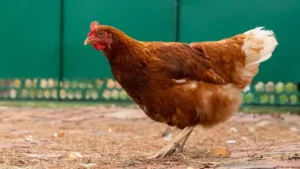

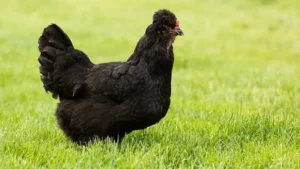
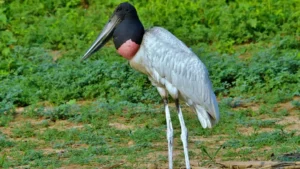

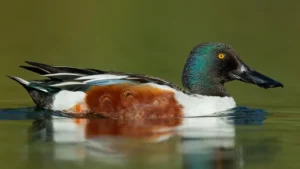
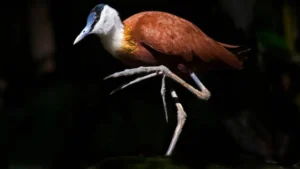
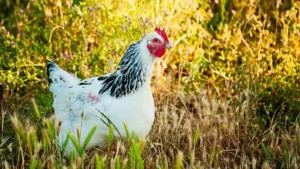
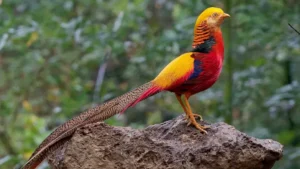
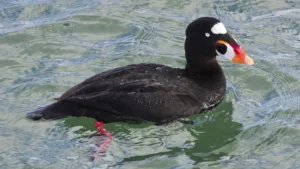

Leave your comment